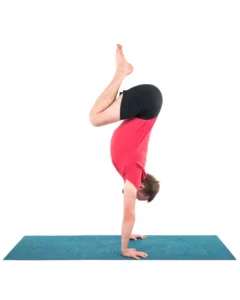5 Ways to Prepare for Firefly Pose in Yoga

I generally don’t write about yoga’s “fancy” poses. I don’t consider these poses to be staples; they’re more like desserts. They’re fun to do occasionally but aren’t really the main course of yoga practice. The main dishes are the basics—standing poses, balancing poses, seated poses, and lying-down poses. Still, occasionally it’s fun to play with fancy poses, such as yoga arm balances. Today, I’d like to feature Firefly Pose (Titibasana) and how to prepare for it.

Titibasana is part of the arm balance category of poses. Like Crane Pose (Bakasana) (shown right), it’s considered to be one of the more basic arm balances. Most practitioners find Crane Pose to be the easier of the two, although Firefly Pose has always been much easier for me. One of the key elements to practicing Titibasana is arm length. Those with long arms are likelier to find this pose pretty easy. But that’s just one element. To practice Titibasana, here are elements that need to be in place:
- Long arms
- Strong, flexible wrists
- Stable and active core
- Flexible abductors and strong adductors
How to Prepare for Firefly Pose
-
Warm Up Your Whole Body
You can start preparing for Titibasana by practicing a few rounds of Surya Namaskar (Sun Salutations). From there, you can prepare for Firefly Pose by addressing the four elements that you need to practice the pose.
-
“Lengthen” Your Arms

As for lengthening one’s arms, well, there’s not a lot you can do about that. But you can place yoga blocks—at their lowest height—under your hands to effectively lengthen your arms. This has worked well for my students.
-
Protect Your Hands and Wrists
Firefly Pose requires extreme flexion in the wrists, along with weight bearing. This makes the pose risky for people with injured or problematic wrists. It’s best not to attempt this pose if your hands or wrists are at all compromised. If you find yourself restricted by the limited range of motion in the wrists, you can use a yoga wedge.
-
Activate Your Core

A strong, activated core may be the most important element in performing any yoga arm balances. To warm up, practice a few rounds of Plank Pose (Phalakasana) and Side Plank Pose (Vasisthasana). You can also learn the proper action for engaging the core in Yoga Squatting Pose (Malasana).
Here’s how to use Malasana to engage your core: From Malasana, squeeze in on your shoulders with your knees. When you do this, notice how your abdominal muscles and organs tone back toward the back, and the back expands. This toning back is the key to stabilizing your body in arm balances.
-
Warm Up Your ADDUCTORS AND ABDUCTORS

In order to get your knees high up on your arms, your hips must be somewhat flexible. Warm up the hips by practicing Reclining Half Lotus Pose, a.k.a. Figure Four Pose (Reclining Half Lotus Pose) and Cow Face Pose (Gomukhasana). Bound Angle Pose (Baddha Konasana) (shown above) can help lengthen your adductors.
How to Practice Titibasana

- Begin in Standing Forward Bend Pose (Uttanasana) on a yoga mat.
- Bend your knees deeply and walk your hands back so that they are on the floor, behind your feet, with your fingers pointing toward the front.
- Bend your knees enough so that your palms can be flat on the floor (or on blocks). Spread your fingers and make sure that your hands are shoulders-width apart.
- Adjust your position so that your knees are as high up on the arms as possible. Then squeeze your knees in on your shoulders so that the core tones back. Maintain this action throughout the pose.
- Gradually begin to shift your weight back, continuing to squeeze in on your shoulders with your knees until your feet start to feel light on the floor.
- Lift your feet off the floor, placing the soles together. Keep squeezing in on your shoulders.
- At this point, you may find yourself falling back onto your rear. If this happens, you can practice just steps 1 through 5 in order to build your technique toward a possible future Firefly Pose.
- After a few breaths, gently allow your hips to release down to the floor. Sit and rest for a few breaths.
- If you want to try again, go for it. Otherwise, practice Downward Facing Dog Pose (Adho Mukha Svanasana), followed by the Revolved Belly Pose (Jathara Parivarttanasana) (shown below) to unwind.

Feel free to practice steps 1 through 5 without ever lifting your feet off the floor. You’ll still receive the core-strengthening, hip-releasing benefits of the pose if you practice all the instructions without lifting your feet off the ground.
Contraindications for Practicing Firefly Pose
If you are dealing with any of the following conditions, it’s best that you skip Firefly Pose:
- Hand or wrist injuries
- Shoulder, elbow, or lower back injuries
- Recent hip replacement surgery
- Pregnancy
- Menstrual period
- Uncontrolled high blood pressure
Also, read...
Healthy Heart: How Yoga Can Help Prevent Heart Disease
Warrior I Pose: 5 Strengthening Variations
Deepening Your Home Yoga Practice: An Interview with Judith Hanson Lasater
Related courses
Breath as Medicine: Yogic Breathing for Vital Aging
Yoga and Myofascial Release: Releasing Chronic Tension with the Bodymind Ballwork Method
Yoga and Detoxification: Tips for Stimulating Lymphatic Health

Charlotte Bell began practicing yoga in 1982 and began teaching in 1986. She was certified by B.K.S. Iyengar in 1989 following a trip to Pune. In 1986, she began practicing Insight Meditation with her mentors Pujari and Abhilasha Keays. Her asana classes blend mindfulness with physical movement. Charlotte writes a column for Catalyst Magazine and serves as editor for Yoga U Online. She is the author of two books: Mindful Yoga, Mindful Life, and Yoga for Meditators, both published by Rodmell Press. She also edits Hugger Mugger Yoga Products’ blog and is a founding board member for GreenTREE Yoga, a non-profit that brings yoga to underserved populations. A lifelong musician, she plays oboe and English horn in the Salt Lake Symphony and the folk sextet Red Rock Rondo whose 2010 PBS music special won two Emmys.



